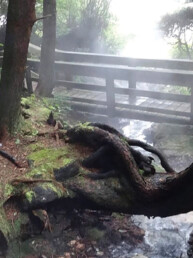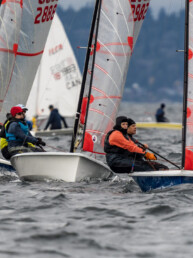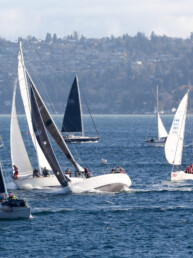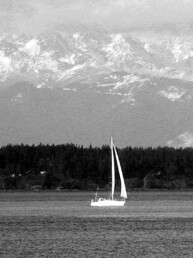An experienced Puget Sound crew heads north for their first ever Southern Straits Race. It left the skipper “satisfied and inspired” and will be the first of many journeys to the springtime classic in the Strait of Georgia.
Our team has been sailing in Puget Sound races for the past 14 years. We learned to race on a J/80 beginning in 2010 and transitioned to Spyhop, a J/109, in 2021. Building experience over the last few seasons with a new-to-us boat, we have been looking for longer races in more open water before someday going offshore.
The Southern Straits Race out of West Vancouver, which crosses the Strait of Georgia, was a natural step in our progression, but one in which none of our crew had ever participated. There are several J/109s based out of Vancouver that we have raced against in Round the County and Anacortes Race Week. Between the new racecourse and the three competitive local J/109s also signed up, we couldn’t resist.

Signing up was not the easy part, since the safety requirements gave us a to-do list emphasizing a level of preparation that we needed time to accomplish. In January, five of our crew rendezvoused in San Diego for a Safety at Sea Course, as this race’s rules require a minimum of two crew members to have taken an offshore safety course. We found the experience very worthwhile, giving us the opportunity to practice the hypotheticals: jump into the water with foulies on and deploy our PFD’s, pull ourselves into a life raft, lift a crew member back onto the boat, set up drogue steering, flare ignition, fire suppression, and Coast Guard rescue coordination. The experience was sobering, especially when considering the conditions in which they would be employed, and has motivated ongoing practice.
Back in Seattle for the spring racing season, we were greeted with unsettled spring weather for the Center Sound Race Series, including a first in a generation Shilshole Bay squall gusting to 50 knots. The Safety at Sea course experience was ever more appreciated when reliving the experience at the clubhouse and considering all the potential misadventures that could have happened. So, with PFDs rearmed, keel bolts torqued, and all the many little but potentially critical things that are usually left for later, our pre-race checklist was finally completed.
The Southern Straits Race started in West Vancouver on Friday, March 29. On Wednesday, we delivered the boat 85 nautical miles north to Blaine on the Canadian border. As we headed up Admiralty Inlet we had breezy conditions that justified practice hoisting the storm sails to make sure we knew how they were rigged. We had a new appreciation for what it would truly be like to hank on a storm sail in high winds after our recent high wind experience—a plan that needed refinement. The infamous storm that developed over the Strait of Georgia in the 2010 Straits race weighed on my mind as I considered our experience. Appreciating how the sea state can build in the Strait of Georgia, I decided if the wind forecast was over 30 knots, we would sit this one out. Thankfully, as the race day forecast settled, the weather models were unanimous that conditions would be moderate, and it was looking to be a fun race.
We departed Blaine Harbor early on Thursday, motor-sailing the 40-mile semicircle from Blaine, west then north around the Roberts Bank delta, and back east into Vancouver to check in at the customs dock. Seeing Vancouver from the water for the first time bordered by ski slopes and rainbows was its own reward for the delivery trip. Once checked in via a phone call to the border agents, we headed west past Stanley Park toward the West Vancouver Yacht Club which is tucked into Fisherman’s Cove, where we were greeted with a slip assignment and a drink at the yacht club bar.
With the boat prepared to meet the Offshore Racing Requirements, provisions stocked and stowed, crew positions and rest-shifts refined, there was time to think about the racecourse and tactical strategies. The yacht club hosted a buffet dinner followed by a weather briefing from Bruce Hedrick, who gave us some tips on what to expect.
Every year, the marks of the Southern Straits courses vary, giving racers a new experience. This year, the middle distance course we would sail took the fleet 50 miles west to the far side of Lasqueti Island, then back east between the mainland and a rock known as the White Islets, before continuing to the finish in Vancouver. By our reading, tidal models didn’t show any predictable advantages that we could see across the racecourse. The wind was forecasted to start from astern out of the east-northeast at 5 to 10 knots and build to 10 to 15 knots for the first 12 hours of the race before a convergence shifted the wind to the west-northwest overnight. The game plan for the first leg was simple: get as far west as we could before the wind switched. Not having ever raced at night, it was hard to strategize for the return leg other than hoping to keep track of other boats and make the best use of the wind (the forecast for which was promising across the course).
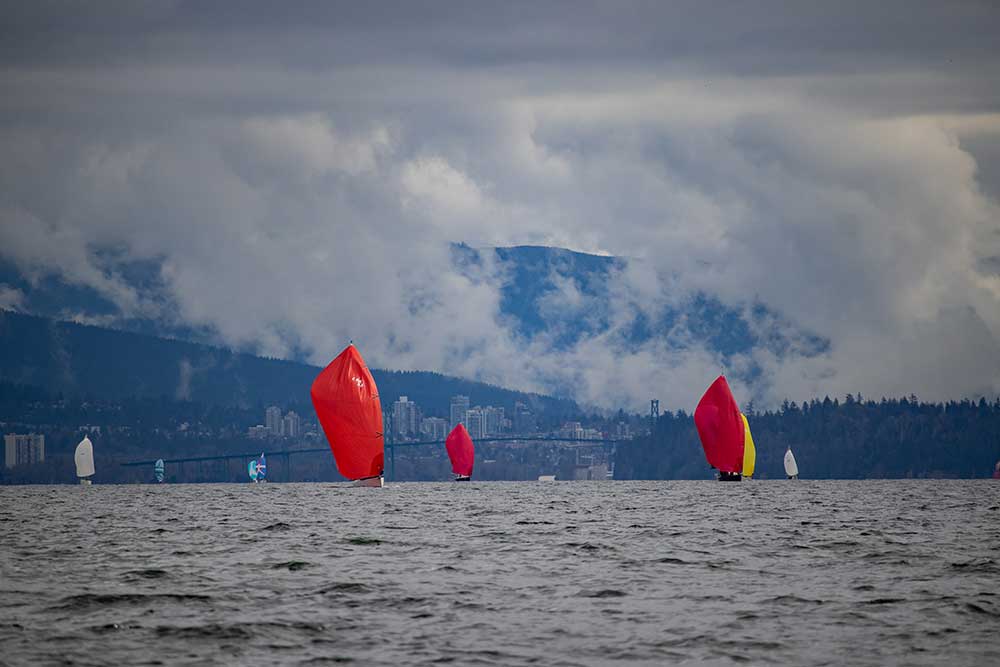
The start was exciting with 29 boats sharing the line and simultaneously hoisting spinnakers and heading out into the strait. After an hour or two, the boats farther south in the center of the strait had made gains where the wind pressure was greater. One of the local J/109s was already 2 miles ahead. The other J/109s had jibed to the north, and we picked the middle road, trailing but in touch. Eventually, our middle road course allowed us to catch up to the other J/109s as the wind clocked west-northwest earlier than expected, and we found ourselves in good pressure and favorable current.
By the time we were off the southeast side of Lasqueti Island, we were crossing tacks with the three J/109s nearby and happy to still have good wind as the sun was dropping on the horizon. Hopes were high that this wind pressure would hold through the night as forecast, even allowing us to entertain the prospect of a hot breakfast ashore. Instead, breeze dropped around sunset as we approached the turnaround point.
A wind shadow developed around us off the coast of Lasqueti and the boats ahead sailed deliberately south toward Qualicum Beach almost 90 degrees away from the rhumb line. Watching the boats heading south now already a few miles away, we did not follow the fleet, trying a more direct course along the lee of Lasqueti. We kept getting lured by short-lived puffs that seemed to bring us east towards the next mark. But after an hour barely moving in the mostly still air of the dark night, I was forced to admit that cutting the corner was not going to work, as the fleet was now 5 miles south of us with more speed. We accepted our fate and altered course to the south as the moon rose in the early morning.

Lesson learned: the “Great Circle Route” that catches the Qualicum Breeze coming through the mountains of Vancouver Island to the south can offer the fastest route back to Vancouver in the early morning.
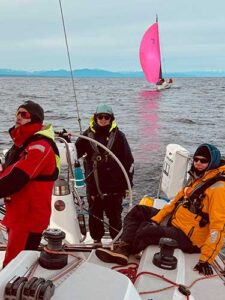
As the sun came up in the early dawn, the wind pressure built into a nice 8 to 12 knots. Once around the White Islets and its stingingly fragrant sea lion colony, we had an enjoyable jibe-filled spinnaker run back toward Vancouver. Playing a fine line between sailing a direct course and reaching out into the strait for more wind pressure, we made up some of the time we had lost overnight.
Then there was only 1 mile to go, with a big wind hole all around the finish line. Poking the boat into the wind hole and literally backing out as the current took over, we had a feeling of déjà vu, recognizing more readily the necessity of the Great Circle Route, this time a 3-mile version tripling the distance to the finish that looked so nearby. In the end, our Spyhop crew completed our first-ever Southern Straits Race, finishing the 99-mile medium course in just under 26 hours and crossing the line as the third of the four J/109s. We ended up winning our class (we were racing under PHRF and the other 109s used ORC), which was a pleasant surprise!

Reliving the race that evening over dinner in North Vancouver, the experience of this race settled in with ever more appreciation for the beautiful scenery, challenging subtleties of the local conditions, and the rich history of the race that marks the start of distance racing for the year in Canada. I was more satisfied and inspired by the experience than I expected to be, and am already looking forward to a new experience of the Southern Straits next year.
Full results at: www.wvyc.ca/on-the-water/racing/southern-straits
Title background image by Robert Torok.


